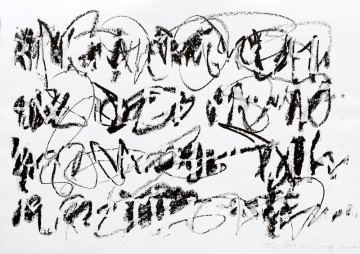Yevgeny Dobrovinsky

Yevgeny Dobrovinsky
Moscow, Russia
Calligrapher, member of the Union of Artists of Russia, member of the Union of Russian Designers, member of the Academy of Graphic Design
And why change anything?!
Calligraphy work only gradually entered into my life. I would do some work designing books, then posters, eventually spending a lot of time on promotional graphics – and getting drawn into script. And all this was somehow curiously linked to the fact that I always had an interest in the East. I read books about Eastern philosophy, culture and, of course, calligraphy. Gradually, this turned into my current profession, and even more – this turned into my requirement, my lifestyle. I got lucky. After all, my favorite activity also earns me my income. Now, I have my own calligraphy school. I have been teaching for over 30 years. First, I taught in a graphic arts institute. Then, at the Higher Academic School of Graphic Design. In the spring and fall, Yury Gulitov and I conduct two-week seminars in Crimea, which attract students from across Russia. I also do a lot of work for myself, doing things like artistic design.
I remember how I went to the first grade in 1951. One of my first classes was in penmanship. We became acquainted with letters with the help of a special pen with a quill. We wrote with effort, dipping the pen into the inkwell. My acquaintance with letters was thus accompanied by a special gesture of the hand – one that, unfortunately, is missing today. Today’s ballpoint pens are far removed from calligraphy. And today’s teachers are far removed from calligraphy, too. Of course, my own teacher was never a master of the quill, either, but she did devote a great deal of attention to proper writing. If we talk about the state of affairs today, then… Well, we have what we have. “And why change anything?!” the skeptics will ask. Sure, we know that the letter A has two little crossbars and a plank. But it can be different, too. There can be all sorts of letters A. I was made aware of this relatively recently, while getting acquainted with calligraphers from the United States who teach calligraphy to technical university students. It turns out that some, especially progressive technical universities in the United States teach calligraphy for development, a sort of compensation that helps people develop fine motor skills in their fingers. And the actual goal here does not rest in developing those fine motor skills – it rests in developing certain areas of the brain that in the future will help students achieve a higher level of professionalism in their fields. But these are pretty lofty matters. Here in Russia, we are not after such spoils. We do not even know what our child will be when they grow up. But it is essential for every person to develop their own handwriting regardless of what they end up doing in life. And in that sense, there is nothing better than studying calligraphy. Moreover, there can be all sorts of different calligraphy activities. A small child does not have to be forced to write out fine calligraphy lettering according to established patterns. It is simply enough to give the child various instruments and show him how they work, encouraging him into taking some dynamic action. What suits each specific child depends on his or her character, since this is all a deeply personal matter.
In general, education and teaching of the arts and crafts is, on the one hand, the realm of highly qualified professionals. But on the other hand, they themselves must not only be craftsmen but also artists. Only then do you begin to understand that an individual approach to teaching is required. There are no common approaches to students. I am convinced that anyone can be taught how to draw, as long as you first find the key. Just as in music, a person who writes might never become a virtuoso. But anyone can illustrate and write well. The most important thing is for a person to overcome their inner inhibitions. And calligraphy represents the best approach possible for that fear. This is a general problem with education. As it so often occurs, it involves a lack of attention to the very basics. Calligraphy stands at the summit of the hierarchy of Eastern arts. This is highest art form. It is the most individualistic and physiological one. It involves numerous skills and subtleties. The teaching methods may vary. Instructions in calligraphy depend heavily on the teacher himself, on his personality. There are as many methods as masters. I, for example, would never be able to follow the teaching methods of another, even most professional calligrapher. I must develop my own. Of this, I am convinced.
The initial boom associated with computerization has passed. Because this virtual life, this artificial medium, subjects made out of artificial materials, artificial love – they represent a standardization. From the dawn of time, human beings defined themselves through natural objects and events. This, in my opinion, is where such interest in calligraphy comes from – in the natural harmony of the art. There is a connection to a person’s physiology, to his individuality, to his spiritual and intellectual development.
When heartfelt insight of the savant reaches its highest plane, this utmost knowledge will take shape in writing. But he who is enamored by surface gloss will never comprehend this truth.“
Author works
Man′s beauty is in the beauty of his writing.









